Patent hysteria: how to stop being afraid of journalistic prejudices
When I see the headlines "Company X patented Y", followed by dozens of angry user comments, I have a grin on my face. Usually, the headlines are followed by emotionally perturbed questions from our customers: “Yes, as they were given such crap!”, “We invent, and they patent what 5 (10, 20 ... choose yourself) years ago know !!!”, “This it’s obvious to the child too! ” And again it is necessary to conduct an educational program about the fact that they have not patented anything yet (read: they did not receive a patent) and not the fact that they will receive ... But let’s go in order.
As soon as we have something patentable (what is possible to get a patent), we document it and submit it in the form of a patent application to the registration office (patent office). After that, our application (whether it is an application for an invention, utility model, industrial design) passes through two stages of examination (such a system is used in most countries of the world) - a stage of formal examination and substantive examination. Only after that a patent is granted (grant), or a decision is taken to refuse to issue a patent. It was after the issuance of the patent that it was possible to say that the invention, utility model, industrial design ( underline the necessary) was patented. Before that (despite the presence of temporary legal protection), this is nothing more than a piece of paper. During the passage of the application of the stages described (and sometimes, when the examinations were passed quickly, even after the grant of the patent), 18 months after filing the patent application materials are published. It is these materials that often become the object of media attention, misinterpreting the source information.
For clarity, let's take a look at an example and estimate the probability of obtaining a patent in the last two cases - the “patent” of the Aug. 7 for monetization of augmented reality and the “patent” for the Apple paper bag.
')
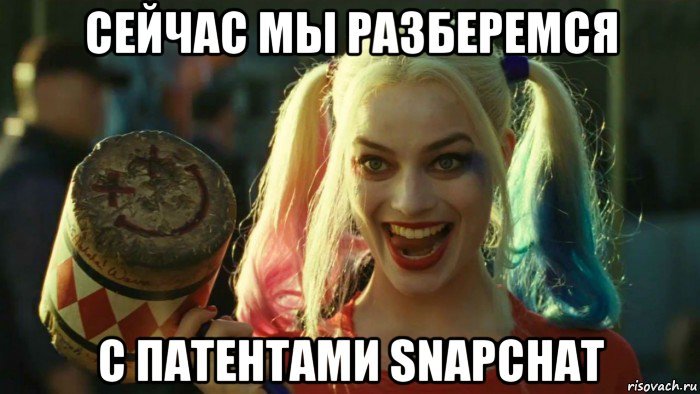
My lunch started a little bit wrong ... a long-time client wrote on Skype:
- Oleg, how can this be patented ???
- This is generally no specifics !!!
And it started ... I had to conduct a small investigation that showed everything that was hidden by the media.
First of all, we go into the public pair (PPAIR is a system for obtaining information on applications already published) and drive in the number ... But the number that we still need to know.
To do this, we analyze the anatomy of a typical publication of a patent / patent application.
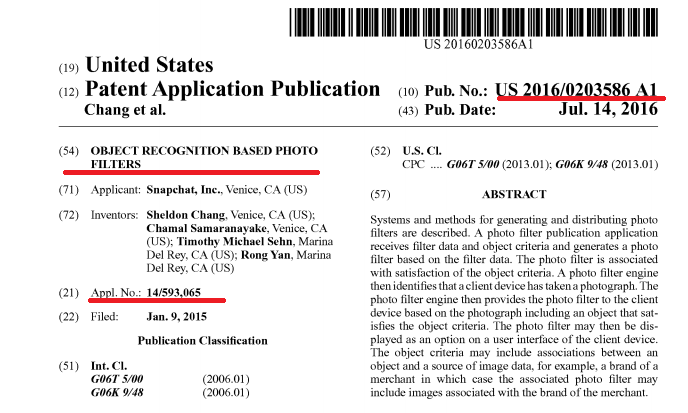
• Field 54 - patent name
• Field 10 - application publication number.
• Field 21 - application number assigned at the time of submission.
In addition, we may be interested in the field 22, which shows the filing date of the application. For the investigation will need all this data.
Having entered PPAIR, according to the application number 14 / 593,065 we find information about the application. Go to the Image File Wrapper tab and see a beautiful footwoman (fragment):
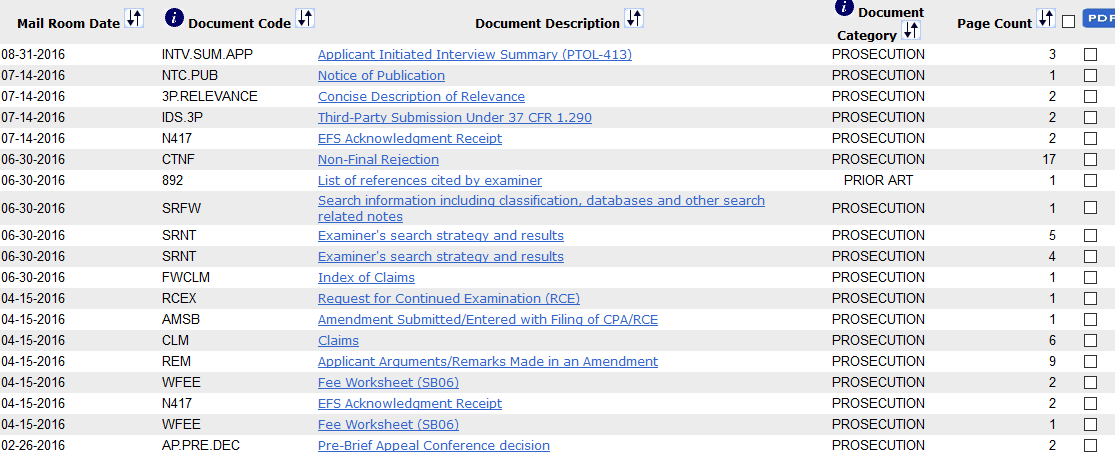
In which nothing is usually incomprehensible) We will be interested only in correspondence with an expert and the arguments of the applicant. We are looking for lines containing Rejection, Arguments, Response, Amendments.
To which the attorneys of the 'a form their arguments to the expert:
And they receive from the expert USPTO Final Rejection, which shows that the arguments of the applicant were weak.
But attorneys do not give up. In vain, do they eat bread?) After all, they are paid by the hour (not what we have :-() And ... they restart the process again.
The expert also does not calm down, and they kick the ball to each other. Attorneys want to dodge and at least get a patent for something, and the expert tells them in response that everything has already beenstolen is invented before you.
At the moment the ball is on the side of the order ... But wait, what is it ...
Some well-wisher filed information on patents or other documents describing principles similar to the application. Let's see what exactly they opposed ...

And who, who did this?

Hmm ...) It seems the author of the application itself ... Which also did not become a patent!
And his argument:

So far, according to my observations, for everything is a little more than sad. A lot of money is invested, but so far there is no use.
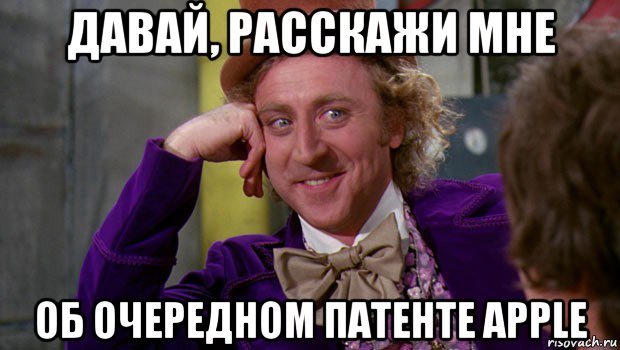
Before I could wake up, new buns from friends flew in to me. Article tjournal.ru told about Apple's application for a paper bag registered on September 15.
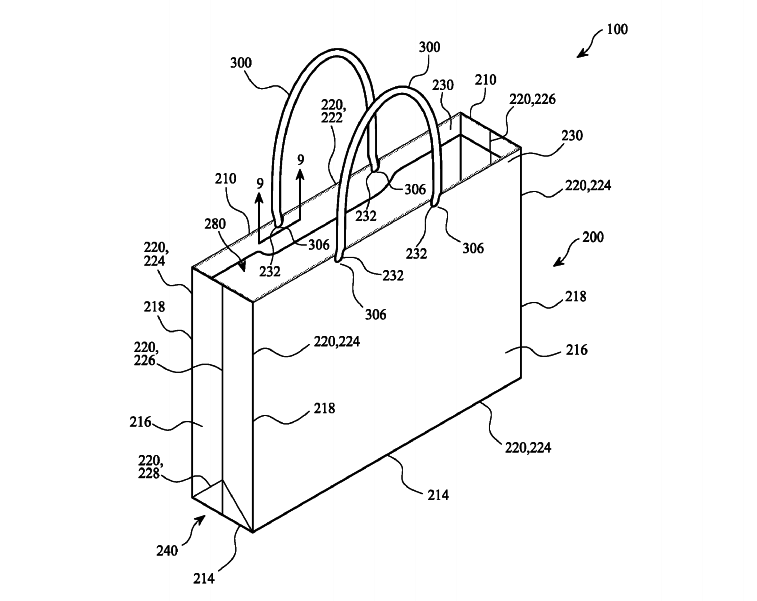
Still the same grin on my face. All the same journalistic prejudices. The screaming phrases like "On September 15, the United States Patent and Trademark Office (USPTO) registered an Apple patent application" cause my particular indignation. We already know how to determine the filing date (and it is incorrectly defined here!). In this case, the journalist makes a logical emphasis on the phrase " registered ." As if it changes something. Any agency registers any application that will bring her, assigning her a specific number. And then the question of examination. We also have a lot of things served in Rospatent. What only a horse massager is worth ...
The next thing that caught my eyes in the article were quotes:
And what other language should describe the invention? Imagine the structure of a human idea that has a technical basis. Imagine people-inventors. Submitted? The class. Now model the process of translating a technical idea into legal-devil-leg-break terminology. Legal language does not accept simple forms, explaining them through dozens of other concepts, twisting the spiral of narration in such a way that you do not remember what it was about at the beginning, as in this sentence. As a result of infinite transformation, the simple to the point of absurdity accumulates an idea of lingual husks.
Also, do not overlook the fact that the examples of patents cited in the article relate to American practice. And in the US, the requirements for applications are much stricter than ours. Any inaccuracy in the description can be a reason for final rejection.
Patents are written in detail so that we, mere mortals, have the opportunity to discuss them in the comments, condemning someone else's work without the slightest idea of its real value. In addition, in the protection of intellectual property there is an important component that journalists are silent about. And this time. Recall that from the filing date of the application, she is already granted temporary legal protection. Therefore, the refusal to register an application due to insufficient “poeticity” of the wording can lead to the fact that you lose not only money but also time. In this regard, there is a risk that a competitor will file a more successful application after us and receive a patent.
As a result of journalistic prejudices, the entire debate about the expediency and reasonableness of specific inventions, such as a paper bag, is unfolded in the comments. Let's not beat around the bush and finally admit that in Russian practice there are also many examples of absurd inventions, which, nevertheless, give businesses certain advantages in the market. Even if the final product does not succeed or does not find its consumer, at least it is possible to sue for patent infringement or to put dust in the eyes of the investor. For example, there is a truly brilliant patent application for a method of flavoring coffee . Of course, no one would ever guess about such a breakthrough technology (sarcasm sign). One very simple idea follows from this: almost all “new” inventions are a modification of already existing forms, improvements that allow one to go through formal legal procedures and re-patent the already patented or obvious ones. Many giants submit applications for everything - let them shoot something.
Let's get rid of the usual semantic content of the word "patent". A patent does not always mean a complex technical device that solves an important human problem. Yes, once upon a time, when only the human imagination began to expand due to new technologies, it was possible to argue nicely that the invention is a symbiosis of imagination and technology. Now, obtaining a patent is nothing more than a legal service, similar to obtaining a document for identification. When we receive a passport, we certify our specific attributes: name, gender, age, date and place of birth, address of registration and marriage and family status. So the patent certifies certain signs of a technical solution, without going into details about the reasonableness and expediency of its issuance, if the application meets legal criteria. That's all.

As soon as we have something patentable (what is possible to get a patent), we document it and submit it in the form of a patent application to the registration office (patent office). After that, our application (whether it is an application for an invention, utility model, industrial design) passes through two stages of examination (such a system is used in most countries of the world) - a stage of formal examination and substantive examination. Only after that a patent is granted (grant), or a decision is taken to refuse to issue a patent. It was after the issuance of the patent that it was possible to say that the invention, utility model, industrial design ( underline the necessary) was patented. Before that (despite the presence of temporary legal protection), this is nothing more than a piece of paper. During the passage of the application of the stages described (and sometimes, when the examinations were passed quickly, even after the grant of the patent), 18 months after filing the patent application materials are published. It is these materials that often become the object of media attention, misinterpreting the source information.
For clarity, let's take a look at an example and estimate the probability of obtaining a patent in the last two cases - the “patent” of the Aug. 7 for monetization of augmented reality and the “patent” for the Apple paper bag.
')
History with

My lunch started a little bit wrong ... a long-time client wrote on Skype:
- Oleg, how can this be patented ???
- This is generally no specifics !!!
And it started ... I had to conduct a small investigation that showed everything that was hidden by the media.
First of all, we go into the public pair (PPAIR is a system for obtaining information on applications already published) and drive in the number ... But the number that we still need to know.
To do this, we analyze the anatomy of a typical publication of a patent / patent application.

• Field 54 - patent name
• Field 10 - application publication number.
• Field 21 - application number assigned at the time of submission.
In addition, we may be interested in the field 22, which shows the filing date of the application. For the investigation will need all this data.
Having entered PPAIR, according to the application number 14 / 593,065 we find information about the application. Go to the Image File Wrapper tab and see a beautiful footwoman (fragment):

In which nothing is usually incomprehensible) We will be interested only in correspondence with an expert and the arguments of the applicant. We are looking for lines containing Rejection, Arguments, Response, Amendments.
05-22-2015 CTNF Non-Final Rejection (preliminary failure). The document lists, on what grounds the expert refuses. An interesting story begins with 4 pages, where the expert opposes the application to the publication of the application US 2014/0176732 .
To which the attorneys of the 'a form their arguments to the expert:
07-22-2015 A ... Amendment / Req. Reconsideration-After Non-Final Reject
07-22-2015 CLM Claims
07-22-2015 REM Applicant Arguments / Remarks Made in an Amendment
And they receive from the expert USPTO Final Rejection, which shows that the arguments of the applicant were weak.
10-15-2015 CTFR Final Rejection
But attorneys do not give up. In vain, do they eat bread?) After all, they are paid by the hour (not what we have :-() And ... they restart the process again.
12-14-2015 A.NE Response After Final Action
12-14-2015 CLM Claims
12-14-2015 REM Applicant Arguments / Remarks Made in an Amendment
The expert also does not calm down, and they kick the ball to each other. Attorneys want to dodge and at least get a patent for something, and the expert tells them in response that everything has already been
At the moment the ball is on the side of the order ... But wait, what is it ...
07-14-2016 IDS.3P Third-Party Submission Under 37 CFR 1.290
Some well-wisher filed information on patents or other documents describing principles similar to the application. Let's see what exactly they opposed ...

And who, who did this?

Hmm ...) It seems the author of the application itself ... Which also did not become a patent!
And his argument:

So far, according to my observations, for everything is a little more than sad. A lot of money is invested, but so far there is no use.
Apple Paper Bag

Before I could wake up, new buns from friends flew in to me. Article tjournal.ru told about Apple's application for a paper bag registered on September 15.

Still the same grin on my face. All the same journalistic prejudices. The screaming phrases like "On September 15, the United States Patent and Trademark Office (USPTO) registered an Apple patent application" cause my particular indignation. We already know how to determine the filing date (and it is incorrectly defined here!). In this case, the journalist makes a logical emphasis on the phrase " registered ." As if it changes something. Any agency registers any application that will bring her, assigning her a specific number. And then the question of examination. We also have a lot of things served in Rospatent. What only a horse massager is worth ...
The next thing that caught my eyes in the article were quotes:
Most of the jokes were caused not even by the patent itself, but by the language in which it was written. According to Sophie Kliman from Gizmodo, since the days of the film American Beauty, the packages have not seemed so poetic ...
According to Brandom, the patent confused many journalists with its thoroughness. The company begins to tell in detail the very essence of the packages, and only to the 35th paragraph comes to really important details.
And what other language should describe the invention? Imagine the structure of a human idea that has a technical basis. Imagine people-inventors. Submitted? The class. Now model the process of translating a technical idea into legal-devil-leg-break terminology. Legal language does not accept simple forms, explaining them through dozens of other concepts, twisting the spiral of narration in such a way that you do not remember what it was about at the beginning, as in this sentence. As a result of infinite transformation, the simple to the point of absurdity accumulates an idea of lingual husks.
Also, do not overlook the fact that the examples of patents cited in the article relate to American practice. And in the US, the requirements for applications are much stricter than ours. Any inaccuracy in the description can be a reason for final rejection.
Patents are written in detail so that we, mere mortals, have the opportunity to discuss them in the comments, condemning someone else's work without the slightest idea of its real value. In addition, in the protection of intellectual property there is an important component that journalists are silent about. And this time. Recall that from the filing date of the application, she is already granted temporary legal protection. Therefore, the refusal to register an application due to insufficient “poeticity” of the wording can lead to the fact that you lose not only money but also time. In this regard, there is a risk that a competitor will file a more successful application after us and receive a patent.
As a result of journalistic prejudices, the entire debate about the expediency and reasonableness of specific inventions, such as a paper bag, is unfolded in the comments. Let's not beat around the bush and finally admit that in Russian practice there are also many examples of absurd inventions, which, nevertheless, give businesses certain advantages in the market. Even if the final product does not succeed or does not find its consumer, at least it is possible to sue for patent infringement or to put dust in the eyes of the investor. For example, there is a truly brilliant patent application for a method of flavoring coffee . Of course, no one would ever guess about such a breakthrough technology (sarcasm sign). One very simple idea follows from this: almost all “new” inventions are a modification of already existing forms, improvements that allow one to go through formal legal procedures and re-patent the already patented or obvious ones. Many giants submit applications for everything - let them shoot something.
Instead of conclusions
Let's get rid of the usual semantic content of the word "patent". A patent does not always mean a complex technical device that solves an important human problem. Yes, once upon a time, when only the human imagination began to expand due to new technologies, it was possible to argue nicely that the invention is a symbiosis of imagination and technology. Now, obtaining a patent is nothing more than a legal service, similar to obtaining a document for identification. When we receive a passport, we certify our specific attributes: name, gender, age, date and place of birth, address of registration and marriage and family status. So the patent certifies certain signs of a technical solution, without going into details about the reasonableness and expediency of its issuance, if the application meets legal criteria. That's all.

Source: https://habr.com/ru/post/311772/
All Articles